Abstract
Clostridium perfringens enterotoxin, when inoculated into the ligated intestinal loop of mice, caused marked distension due to fluid accumulation. The increase in weight of the intestinal loop was proportional to the log dose of enterotoxin within a range from 1 to 16 micrograms. The fluid accumulation was arrested by washing the loop with saline or by injection of the specific anti-enterotoxin serum into the loop 5 or even 30 min after inoculation of the enterotoxin. A significant increase in weight of the loop was found as early as 10 min after inoculation of the toxin. These results may suggest that entergotoxin is neither bound firmly to the mucosal membrane nor permeates into the cells of the intestinal wall. The mouse intestinal loop test is economical, simple to perform, and applicable for quantitative determination of the enteropathogenic activity of C. perfringens enterotoxin.
Full text
PDF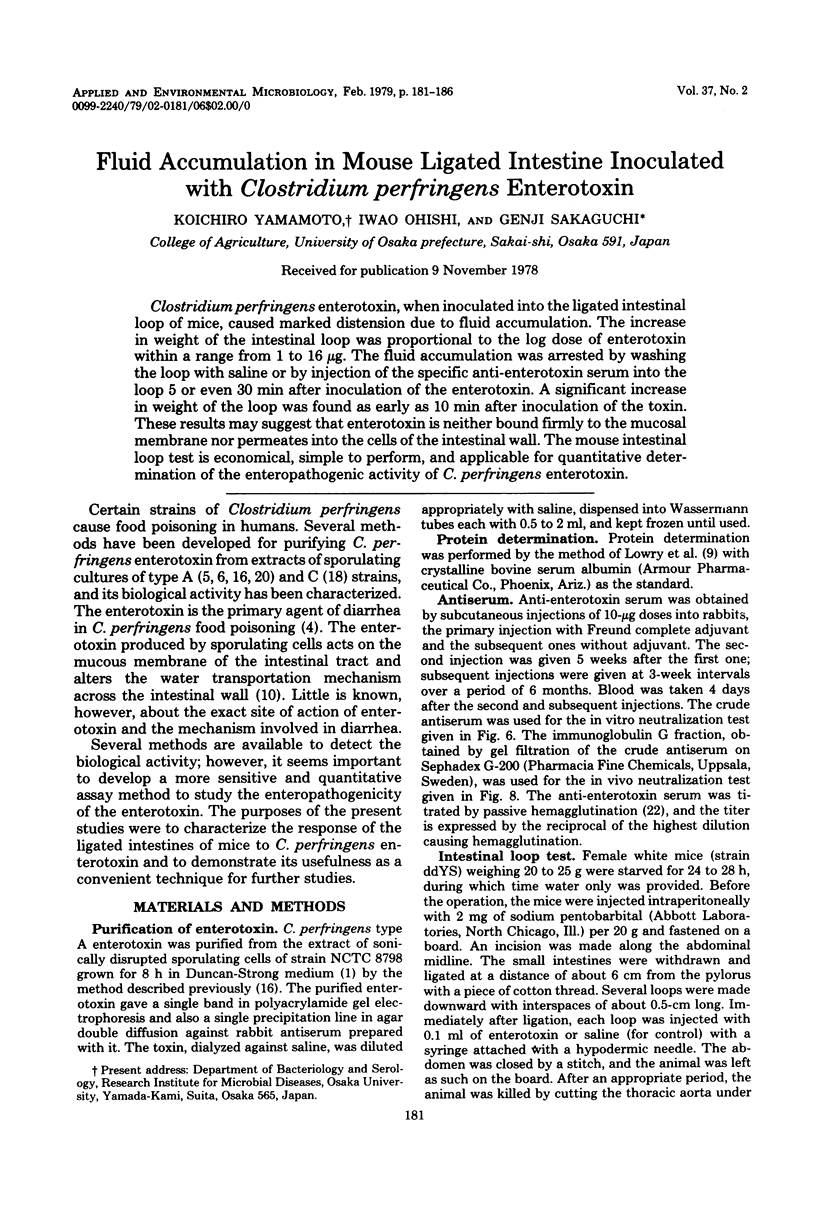
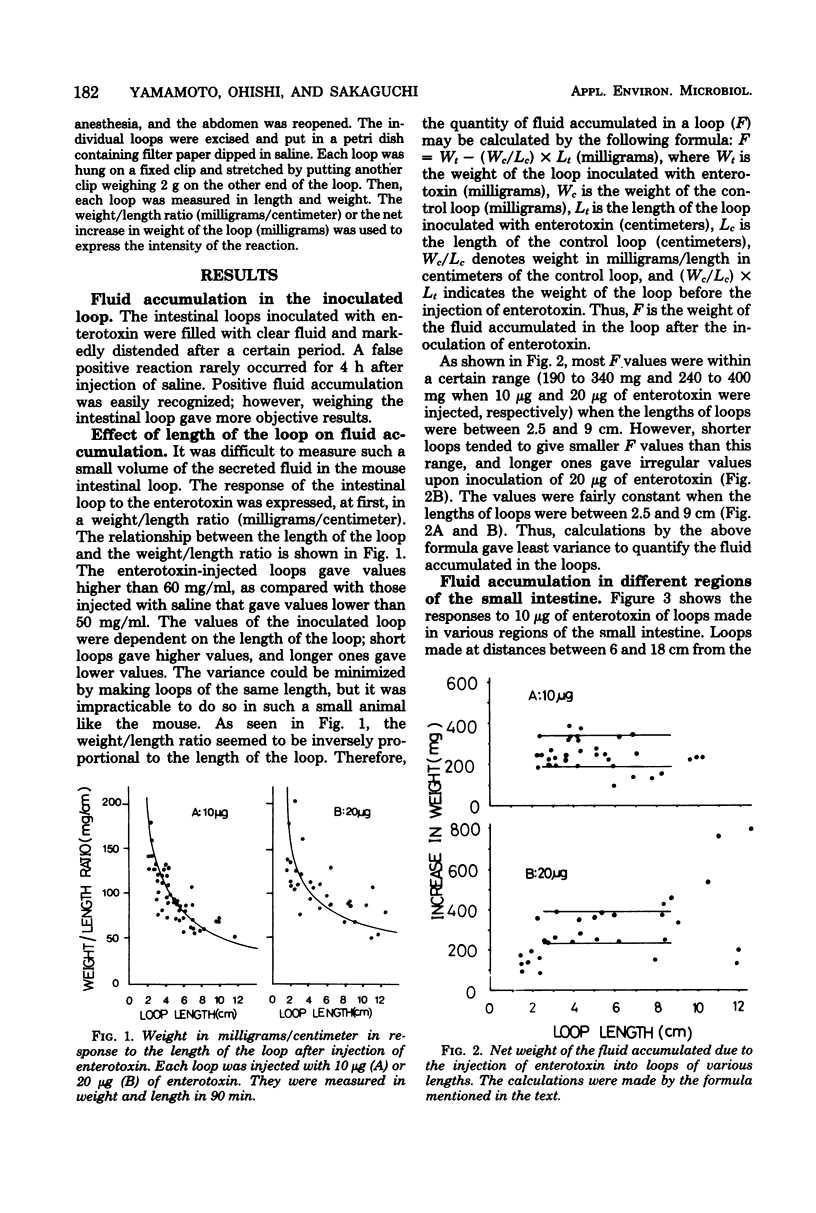
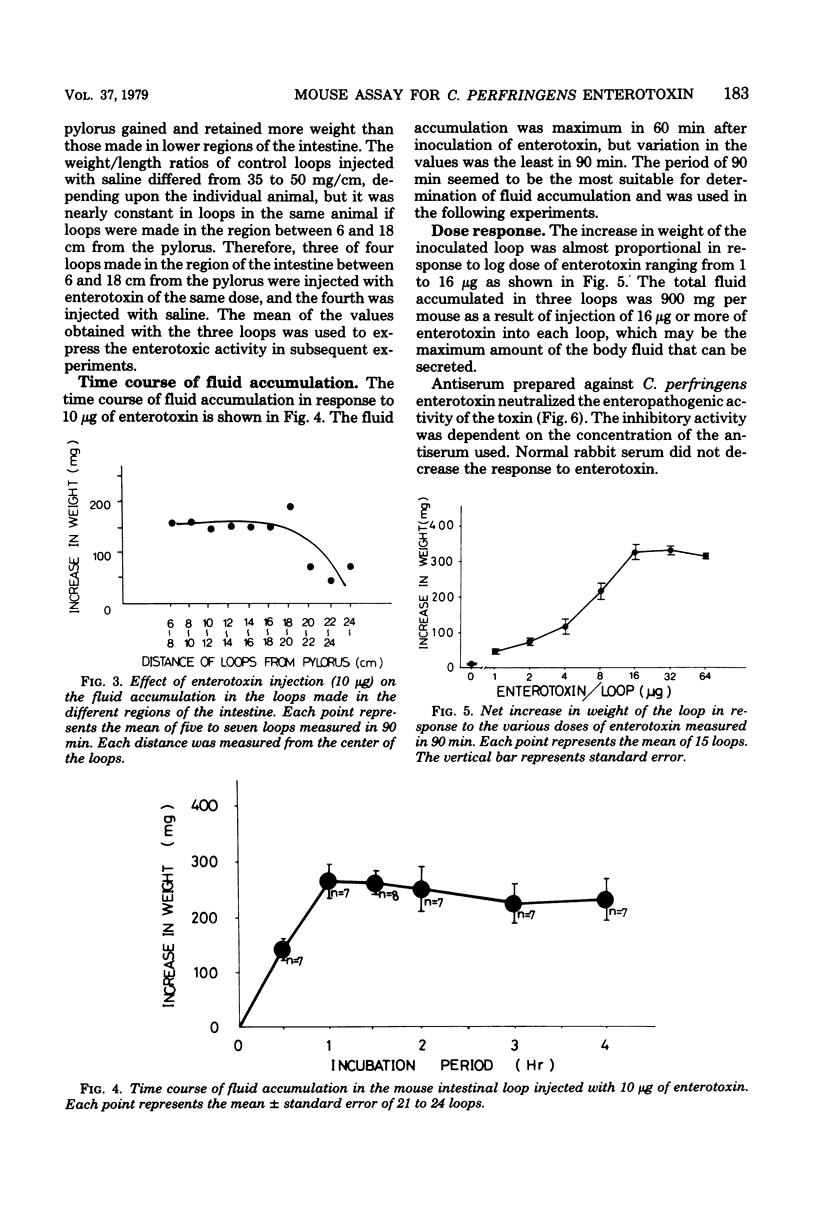
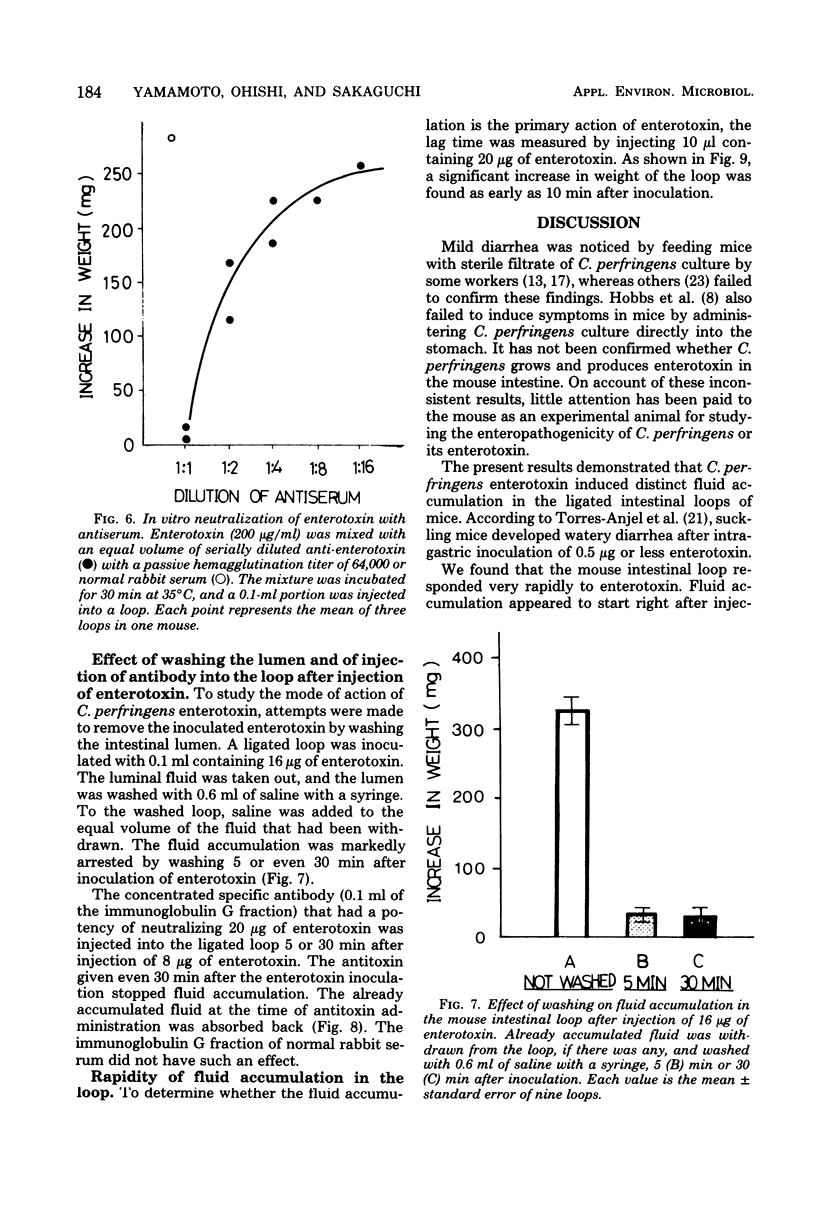

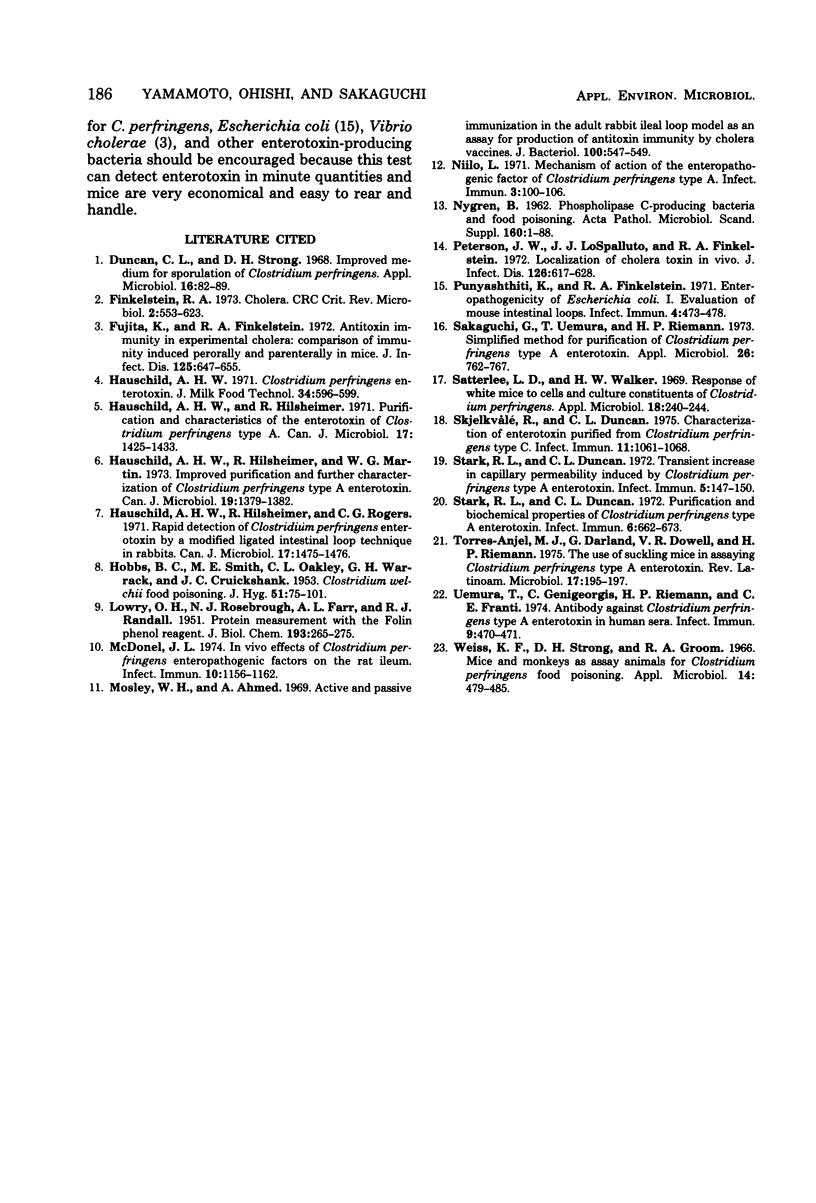
Selected References
These references are in PubMed. This may not be the complete list of references from this article.
- Duncan C. L., Strong D. H. Improved medium for sporulation of Clostridium perfringens. Appl Microbiol. 1968 Jan;16(1):82–89. doi: 10.1128/am.16.1.82-89.1968. [DOI] [PMC free article] [PubMed] [Google Scholar]
- Fujita K., Finkelstein R. A. Antitoxic immunity in experimental cholera: comparison of immunity induced perorally and parenterally in mice. J Infect Dis. 1972 Jun;125(6):647–655. doi: 10.1093/infdis/125.6.647. [DOI] [PubMed] [Google Scholar]
- HOBBS B. C., SMITH M. E., OAKLEY C. L., WARRACK G. H., CRUICKSHANK J. C. Clostridium welchii food poisoning. J Hyg (Lond) 1953 Mar;51(1):75–101. doi: 10.1017/s0022172400015515. [DOI] [PMC free article] [PubMed] [Google Scholar]
- Hauschild A. H., Hilsheimer R., Martin W. G. Improved purification and further characterization of Clostridium perfringens type A enterotoxin. Can J Microbiol. 1973 Nov;19(11):1379–1382. doi: 10.1139/m73-222. [DOI] [PubMed] [Google Scholar]
- Hauschild A. H., Hilsheimer R. Purification and characteristics of the enterotoxin of Clostridium perfringens type A. Can J Microbiol. 1971 Nov;17(11):1425–1433. doi: 10.1139/m71-227. [DOI] [PubMed] [Google Scholar]
- Hauschild A. H., Hilsheimer R., Rogers C. G. Rapid detection of Clostridium perfringens enterotoxin by a modified ligated intestinal loop technique in rabbits. Can J Microbiol. 1971 Nov;17(11):1475–1476. doi: 10.1139/m71-235. [DOI] [PubMed] [Google Scholar]
- LOWRY O. H., ROSEBROUGH N. J., FARR A. L., RANDALL R. J. Protein measurement with the Folin phenol reagent. J Biol Chem. 1951 Nov;193(1):265–275. [PubMed] [Google Scholar]
- McDonel J. L. In Vivo Effects of Clostridium perfringens Enteropathogenic Factors on the Rat Ileum. Infect Immun. 1974 Nov;10(5):1156–1162. doi: 10.1128/iai.10.5.1156-1162.1974. [DOI] [PMC free article] [PubMed] [Google Scholar]
- Mosley W. H., Ahmed A. Active and passive immunization in the adult rabbit ileal loop model as an assay for production of antitoxin immunity by cholera vaccines. J Bacteriol. 1969 Oct;100(1):547–549. doi: 10.1128/jb.100.1.547-549.1969. [DOI] [PMC free article] [PubMed] [Google Scholar]
- NYGREN B. Phospholipase C-producing bacteria and food poisoning. An experimental study on Clostridium perfringens and Bacillus cereus. Acta Pathol Microbiol Scand Suppl. 1962;Suppl 160:1–88. [PubMed] [Google Scholar]
- Niilo L. Mechanism of Action of the Enteropathogenic Factor of Clostridium perfringens Type A. Infect Immun. 1971 Jan;3(1):100–106. doi: 10.1128/iai.3.1.100-106.1971. [DOI] [PMC free article] [PubMed] [Google Scholar]
- Peterson J. W., LoSpalluto J. J., Finkelstein R. A. Localization of cholera toxin in vivo. J Infect Dis. 1972 Dec;126(6):617–628. doi: 10.1093/infdis/126.6.617. [DOI] [PubMed] [Google Scholar]
- Punyashthiti K., Finkelstein R. A. Enteropathogenicity of Escherichia coli. I. Evaluation of mouse intestinal loops. Infect Immun. 1971 Oct;4(4):473–478. doi: 10.1128/iai.4.4.473-478.1971. [DOI] [PMC free article] [PubMed] [Google Scholar]
- Sakaguchi G., Uemura T., Riemann H. P. Simplified method for purification of Clostridium perfringens type A enterotoxin. Appl Microbiol. 1973 Nov;26(5):762–767. doi: 10.1128/am.26.5.762-767.1973. [DOI] [PMC free article] [PubMed] [Google Scholar]
- Satterlee L. D., Walker H. W. Response of white mice to cells and culture constituents of Clostridium perfringens. Appl Microbiol. 1969 Aug;18(2):240–244. doi: 10.1128/am.18.2.240-244.1969. [DOI] [PMC free article] [PubMed] [Google Scholar]
- Skjelkvålé R., Duncan C. L. Characterization of enterotoxin purified from Clostridium perfringens type C. Infect Immun. 1975 May;11(5):1061–1068. doi: 10.1128/iai.11.5.1061-1068.1975. [DOI] [PMC free article] [PubMed] [Google Scholar]
- Stark R. L., Duncan C. L. Purification and biochemical properties of Clostridium perfringens type A enterotoxin. Infect Immun. 1972 Nov;6(5):662–673. doi: 10.1128/iai.6.5.662-673.1972. [DOI] [PMC free article] [PubMed] [Google Scholar]
- Stark R. L., Duncan C. L. Transient increase in capillary permeability induced by Clostridium perfringens type A enterotoxin. Infect Immun. 1972 Jan;5(1):147–150. doi: 10.1128/iai.5.1.147-150.1972. [DOI] [PMC free article] [PubMed] [Google Scholar]
- Torres-Anjel M. J., Darland G., Dowell V. R., Riemann H. P. The use of suckling mice in assaying Clostridium perfringens Type A enterotoxin. Rev Latinoam Microbiol. 1975 Oct-Dec;17(4):195–197. [PubMed] [Google Scholar]
- Uemura T., Genigeorgis C., Riemann H. P., Franti C. E. Antibody against Clostridium perfringens type A enterotoxin in human sera. Infect Immun. 1974 Feb;9(2):470–471. doi: 10.1128/iai.9.2.470-471.1974. [DOI] [PMC free article] [PubMed] [Google Scholar]
- Weiss K. F., Strong D. H., Groom R. A. Mice and monkeys as assay animals for Clostridium perfringens food poisoning. Appl Microbiol. 1966 Jul;14(4):479–485. doi: 10.1128/am.14.4.479-485.1966. [DOI] [PMC free article] [PubMed] [Google Scholar]


